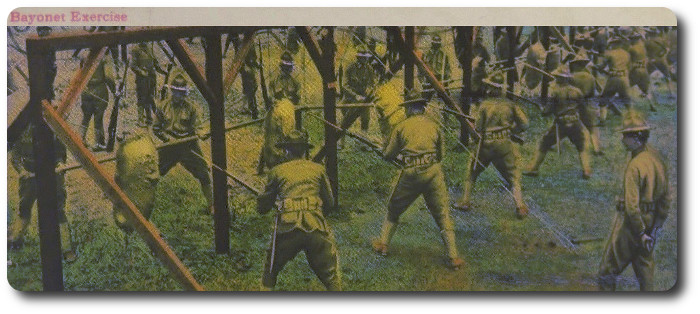Topic: Cold Steel

Cold Steel Yet Winner of Wars
Doughboy and Bayonet Are Hopes in Battle, Says Army Questionnaire
Tin Hat His Armor
Clothed Only Against Weather and With "Own Agility Is Most Vulnerable"
"That man remains the fundamental instrument in battle, as as such can not be replaced by any imaginable instrument short of a more perfect thing than the human body, including the mind."
The Spokesman-Review, Spokane, Washington, 14 February 1922
By Associated Press
Washington, Feb 13.—The "dough boy" with a bayonet still is the "basic combatant" unit in battle. This is the virtually unanimous judgment of the American army, officially rendered in cold post-war analysis. Aircraft, tanks, bombs, machine guns, cannon, merely are valuable auxiliaries for the infantry "man in the bulk," armed with rifle and bayonet, and each foot soldier armored only by his "own agility" and a steel helmet.
For "battle is normally determined by physical encounter with the bayonet or the fear thereof," the official conclusion of the army made public today asserted. It is based on answers to a widespread "questionnaire sent recently through the war department bureaus and out through corps and divisional areas, even down to commanders of regiments, to lay the ground work for the doctrines of tactics and of training on which post-war building of the army shall proceed."
Cold Steel Always Best
The answers were unmistakable. There has been no change—soldiers who fought in France believe in the age-old-gospel of "cold steel" in war. As it was with Cromwell's grim host, striving for victory "with push of pike," with Napoleon's old guard that "dies but never surrenders," with Pickett's flower of the south" at Gettysburg, so it was with Pershing's "buddies" in France. Cold steel was the ultimate arbiter of battle.
The conclusion follows "an exhaustive study of the influence that modern scientific development will have upon the technique of warfare, especially with regard to aviation, motor transport and tanks." Chiefs of all combat branches had their say on the questionnaire, designed to bring out the best present military thought," both on basic principles and as to changes in fighting technique necessitated by new weapons.
Planes and Guns at Issue
As the research work goes on tests will be made "to solve debatable questions." Among these is the "comparative value of bombing planes and fixed heavy guns in sea coast defences."
"It is possible at this time," the statement added, "to announce the conclusion of the war department resulting from the answers to the basic question as to which there was substantially unanimous agreement. It is concluded, and doctrines of tactics and of training will be based accordingly:
"That man remains the fundamental instrument in battle, as as such can not be replaced by any imaginable instrument short of a more perfect thing than the human body, including the mind."
Fights Best on Foot
"That man in the bulk—meaning the greater portion of the armed forces—fights with the greatest freedom of action and with greatest efficiency when on foot, not on horseback, in a tank, in an airplane, in a fixed fortification, etc.
"That to achieve decisive action he is best armed with the rifle and bayonet or the fear thereof; all other [arms support the infantry soldier who is most] vulnerable when merely clothed against the weather and armored by his own agility with steel helmet.
"That battle is normally determined by physical encounter with the bayonet or the fear thereof, all other agencies of destruction, as artillery, machine guns and aircraft, are auxiliary in their effect, however potent, and serve to make possible the advance of the foot soldier to hand-to-hand encounter.
"That infantry is the basic combat arm upon whose success normally depends the success of the army; the primary duty of other arms when associated with infantry is to assist the infantry to achieve its mission by protecting and aiding it in every way and by destroying enemy resistance to its efforts.
Infantry Against Infantry
"That no arm except infantry can be expected under normal conditions to destroy an approximately equal force of enemy infantry armed with rifle and bayonet.
"That while infantry is normally the basic arm of war, under certain circumstances or during certain phases, cavalry may replace it as the basic arm, for example in operations against mounted forces or against foot troops whose efficiency is below normal for any reason."
Misconceptions arise in the public mind, the statement said, as to the possible efforts of new agencies of war and in making public results of its studies the war department "hopes to insure that the heresymerely clothed against the weather shall never become implanted in the country that any material means can ever replace in war the individual soldier who is willing and able to fight."

